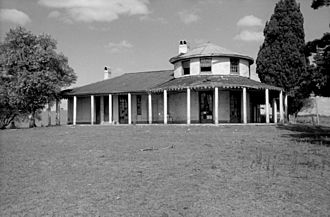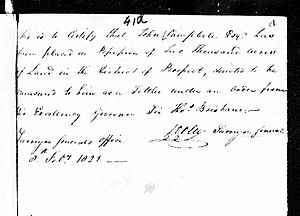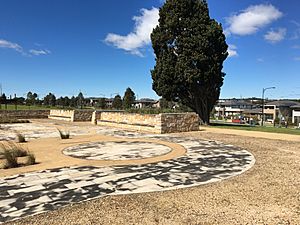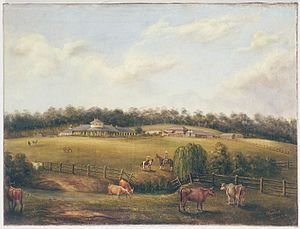Bungarribee Homestead Site facts for kids
Quick facts for kids Bungarribee Homestead archaelogical site |
|
|---|---|
| Lua error in Module:Location_map at line 420: attempt to index field 'wikibase' (a nil value). | |
| Location | Doonside Road, Doonside, City of Blacktown, New South Wales, Australia |
| Official name: Bungarribee Homestead Complex - Archaeological Site; Bungarribee House | |
| Type | state heritage (archaeological-terrestrial) |
| Designated | 8 December 2000 |
| Reference no. | 1428 |
| Type | Homestead Complex |
| Category | Farming and Grazing |
| Builders | John Campbell, Thomas Icely, Charles Smith and John Kingdon Cleeve |
| Bungarribee Homestead | |
|---|---|

Ruinous Bungarribee Homestead in 1954. The Italian Cypress, at right, still marks the site.
|
|
| General information | |
| Architectural style | Cottage orné |
| Town or city | Bungarribee Sydney New South Wales |
| Country | Australia |
| Construction started | c.1822–1827 |
| Demolished | May 1957 |
| Client | John Campbell |
The Bungarribee Homestead Site is a special heritage-listed place in Doonside, Sydney, Australia. It's where the old Bungarribee Homestead used to stand. This site is important because it holds clues about early Australian history. It was added to the New South Wales State Heritage Register on 8 December 2000, meaning it's protected for future generations.
Contents
History of Bungarribee
The Darug People's Land
Before European settlers arrived, the land around Bungarribee belonged to the Warrawarry group of the Darug people. They lived off the land, hunting and gathering food from Eastern Creek and the nearby forests. They found fish, crayfish, shellfish, and many plants.
When Europeans began settling in western Sydney after 1790, life changed greatly for the Aboriginal people. Many groups had to join together to survive. As settlers cleared land, it became harder for the Darug people to find their traditional foods. This led to difficult times between the two cultures. By the early 1800s, the Darug population had sadly shrunk to a small number.
For a long time, people thought "Bungarribee" meant "the burial place of a king." They believed it was named after an Aboriginal man called Bungaree. However, we now know that Bungaree was from a different area. Today, experts believe "Bungarribee" comes from two Darug words that mean "creek with cockatoos" or "creek with campsite." This makes sense because the creeks in the area don't always have water.
Government Farm at Rooty Hill
From 1802 to about 1815, the Bungarribee area was part of a much larger Rooty Hill Government Farm. Governor King set up this farm to provide good land for government animals. He also wanted to prevent a few people from controlling the colony's food supply.
The farm mostly stayed in its natural state. There were simple huts for overseers, convicts, and shepherds. There were also fences for grazing areas. In 1810, Governor Macquarie decided to divide the large farms into smaller pieces for free settlers. He believed the colony no longer needed such big government farms for food.
John Campbell's Estate

Around 1815, Governor Macquarie started giving out parts of the Rooty Hill Farm to settlers. This began organized farming by Europeans in the area. One of the biggest pieces of land, 2000 acres, went to John Campbell in about 1822.
John Campbell was a major in the British Army. He arrived in Sydney on November 30, 1821, with his wife, Annabella, and their nine children. He wanted to make his fortune through farming. One of his great-great-grandsons, Sir Walter Campbell, later became a judge and Governor of Queensland.
Campbell quickly started clearing and farming his land with the help of 22 convict laborers. He built a temporary home on a high spot. In 1822, records show he had 130 acres cleared, with crops like wheat, barley, and potatoes. He also had cattle, hogs, and a horse.
Between 1822 and 1824, Campbell expanded his land and named his estate "Bungarribee." He soon began building a grand new home that matched his status as a former officer. The main part of the house was circular, with one room on each of its two floors. This meant all windows, doors, and fireplaces had to be curved, which was a very difficult task for the builders at the time. Yet, they did it, and the house stood for over 100 years!
Campbell placed his new house on the highest hill, facing west. This gave amazing views of the Blue Mountains. The house became a well-known landmark. Even though the house is gone now, some of the original trees, like Bunya pines and Mediterranean cypresses, still mark the spot.
Besides the house, many other buildings were built. These included a brick barracks for convicts, a large brick barn, stables, a blacksmith's shop, and a carpenter's shop. The estate also had a large garden, about 8 acres, with many fruit trees. This garden was big enough to feed everyone living and working there.
John Campbell faced financial problems while building Bungarribee. Sadly, his wife Annabella died in November 1826, followed by John himself in October 1827. They are both buried in Parramatta.
Thomas Icely's Ownership
In 1828, Bungarribee was sold to Thomas Icely. He was a very successful pastoralist, meaning he owned and managed large areas of land for raising livestock. He used Bungarribee mainly for breeding and fattening horses, cattle, and sheep.
In those days, moving animals or wool was very slow because roads were poor. So, having an estate like Bungarribee close to Sydney was very useful for country properties. An 1832 survey showed the house, outbuildings, and large formal gardens. These gardens were designed in a grid pattern, similar to ideas from famous garden designers of the time.
Charles Smith and Horse Breeding
Charles Smith, a famous horse breeder, lived at Bungarribee from 1832 to 1840. He owned many top racehorses. Later, the property was leased to Joseph Armstrong. Smith died in 1845.
East India Company and Later Owners
From about 1843 to 1851, the British East India Company used Bungarribee as a place to gather horses. These horses were then sent to India for their army. After the company, the property was used again for horse breeding, cattle grazing, farming, and dairying.
Over the years, the buildings on the estate changed. By 1935, the old homestead was described as "standing like a battered old man," showing its age.
Military and Demolition
Around 1941, the Australian government took over most of the Bungarribee estate for military use during World War II. They built a sealed runway for training and as an emergency landing strip for nearby airbases. The house itself, however, remained with its last private owner, Thomas Cleaver.
In 1949, the Overseas Telecommunications Commission (OTC) bought the site. They planned to build a new international radio station there. Sadly, despite efforts from local groups to save it, Bungarribee Homestead was demolished in May 1957. It had been empty for years and was considered beyond repair. Only a two-story brick barn survived for a while, used by OTC for storage.
By the 1990s, new technology meant the radio station was no longer needed. The OTC site closed, and its buildings were removed by 2001.
Recent Changes
In June 2000, archaeologists dug up the site. They found the remaining walls, floor surfaces, and foundations of the homestead. They could clearly see the circular part of the building and its two wings. They also found the servants' area, a kitchen fireplace, and cobbled stone flooring from other old buildings. These findings showed how well preserved the site was.
Today, you can still see parts of the old garden, with tall Bunya pines and other mature trees marking where the homestead once stood.
In 2015, plans were approved for a new zoo, the Sydney Zoo, next to Bungarribee's picnic area. In March 2017, the $15 million Bungarribee Park opened. It's now the biggest recreational space in Western Sydney, with protected wetlands and thousands of new native trees.
Changes Over Time
- 1822: John Campbell starts building the homestead.
- 1828: Thomas Icely buys the property.
- 1832: A survey shows the house, outbuildings, and large formal gardens.
- 1846: The British East India Company uses the site as a horse stud.
- 1942: The military takes over part of the estate and builds a runway.
- 1957: Bungarribee Homestead is demolished.
- 2000: Archaeological digs uncover the homestead's foundations.
- 2017: Bungarribee Park opens as a large public space.
What the Site Looks Like Now
The Old Farm Site
The Bungarribee Homestead site is now part of the former Overseas Telecommunications Commission (OTC) land in Doonside. It covers a large area, about 2.6 by 1.6 kilometers. This land was originally part of the 2000 acres given to John Campbell in 1823.
Archaeologists believe the site has a very high potential to reveal more about the past. The foundations of the 1820s homestead, including the main house, outbuildings, and original garden plantings, are mostly still there and well preserved underground.
Gardens and Grounds
Above ground, you can still see parts of the old Bungarribee estate garden. There are tall, old trees like Bunya pines, hoop pines, and Mediterranean cypresses. These trees are important landmarks that show where the homestead and its garden used to be. An 1832 map also showed an 8-acre formal kitchen garden and an orchard.
The Old Homestead
Bungarribee Homestead was a historic house built for John Campbell between 1822 and 1828. It was known for its unique design and was sadly demolished in 1957. The site is now a heritage-listed archaeological area.
The house was not fully finished when John Campbell died. It had a dining room and five bedrooms on the ground floor, and four smaller rooms upstairs. A special feature was its two-story, circular tower with a conical roof. Two single-story wings extended from it, forming an L-shape. The walls of the circular part were made of solid bricks. The house also had large verandahs with stone floors and a cellar.
The main circular part of the house had one room on each floor, both completely round. This meant all the windows, doors, and even fireplaces had to be curved! This was a very difficult building challenge, showing the great skill of the builders. The house was built in a style called "Picturesque," which was popular in England at the time.
The Homestead's Architecture
We don't know who designed Bungarribee Homestead. It was described as an "L-shaped house with a drum at the junction of the two arms." The "drum" was the base of the circular tower with its conical roof. The tower had a drawing room on the ground floor. Because of the curved walls, the doors inside this room were also curved.
From the outside, the homestead looked charming. It was known for its "simple and stately style" and its long verandahs. The house was unique, combining different shapes, and was one of the earliest examples of the "cottage orné" style in Australian architecture.
Today, the foundations of the homestead can be seen thanks to archaeological digs in 2000. The old Bunya pines and other trees still mark the spot, which is now part of Heritage Park in Bungarribee.
Other Buildings on the Farm
Besides the main house, there were many other important buildings. These included a brick barracks for convicts, a large brick barn, stables, a blacksmith's shop, and a carpenter's shop.
The barn was a huge brick building. The men's quarters, possibly for servants, were behind the barn and had brick floors. Over time, some of these buildings changed how they were used.
When archaeologists dug at the site in 2000, they found the remains of the homestead's walls and floors. They also found parts of the servants' area, a kitchen fireplace, and stone cobbled flooring from other old buildings. They found pieces of glass, ceramics, and other old household items.
While some parts have been found, other buildings like cellars, stockyards, and a blacksmith's shop are still waiting to be discovered. The site also has some contaminated soil, but most of the asbestos was removed in 2000.
Changes and Decline
Over the years, Bungarribee Homestead had many owners and tenants. The British East India Company used it to gather horses for their troops in India.
In the early 1900s, the estate was divided into smaller pieces. The house was bought by Charles W. Hopkins, who spent a lot of money restoring it. However, by the 1930s, the house was again in disrepair. During World War II, the military took over the property, and the house suffered more damage.
By the 1950s, Bungarribee was in very bad condition. Even though a local historian offered to restore it at his own cost, the offer was turned down, and the homestead was demolished in 1957. Only a two-story brick barn remained for a while, used for storage, until it was also demolished in 1977.
Why Bungarribee is Important
The Bungarribee Homestead site is very important because it shows us what an early Australian farmstead looked like. It includes the rare, mostly untouched foundations of the main house, other buildings, and garden plantings. This site helps us understand the history of New South Wales.
The homestead is strongly connected to John Campbell, an early settler who came to Australia to make his fortune. Bungarribee shows the dreams and efforts of early settlers. The house itself was also special for its architecture, influencing the "cottage orné" style in the colony. Its unique tower was a famous landmark.
As an archaeological site, Bungarribee can teach us a lot. It can provide information about how the homestead was built and used, and about the daily lives of early settlers, including the workers and farm assistants. Because the homestead was occupied for so long, from 1823 to 1957, it can also tell us about how farming and the economy changed in early rural Sydney.
The Bungarribee Homestead archaeological site was listed on the New South Wales State Heritage Register on 8 December 2000 because it meets several important criteria:
- It shows the history of New South Wales: The site helps us understand the early settlement and farming in western Sydney. It has strong ties to John Campbell and other early settlers who aimed to build a new life.
- It shows great design and creativity: The homestead was beautiful and well-designed, with amazing views of the landscape. Its circular room and verandahs were unique features that influenced later designs. The old pine trees on the site also remind us of the early European influence on the environment.
- It has special meaning for the community: Before it was demolished, Bungarribee Homestead was a well-known landmark. Many local people have childhood memories and stories about the grand house and its large barn. Historically, the farm also provided jobs and supported the local economy.
- It can teach us new information: The site has the potential to reveal much more about early farming, the construction of the homestead and its other buildings, and the daily lives of the people who lived and worked there.
Images for kids








